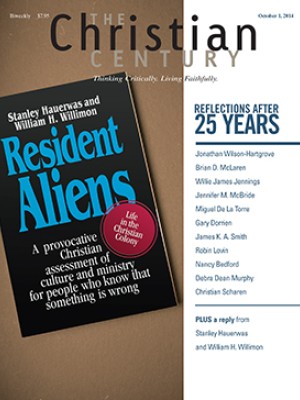Sunday, October 12, 2014
The story of the golden calf is a parody of Israelite idolatry.
J. Louis Martyn describes Galatians as a sermon that addresses two questions: What time is it, and whose world is it? In fact, most if not all of the Bible can be fruitfully read through these two questions—which, given the growing array of tempests, idols, obsessions, and distractions that cloud our vision and dull our ears, are as pressing now as ever. These questions also provide a framework for this week’s readings.
The story of the golden calf is a parody of Israelite idolatry. When the Israelites grow weary of waiting while God speaks to Moses, they demand that Aaron “make gods for us, who shall go before us.” Before the calf is cast, the people name Moses as “the man who brought us up out of the land of Egypt,” but as soon as the calf is finished, they announce, “These are your gods, O Israel, who brought you up out of the land of Egypt!” Both statements deny the reality affirmed at the beginning of the Decalogue: “I am the Lord your God, who brought you out of the land of Egypt, out of the house of slavery” (Exod. 20:2).
Read our latest issue or browse back issues.
The golden calf symbolizes not only the breaking of the first two commandments but also the people’s short memories and wobbly convictions. Perhaps Aaron, who apparently holds a cynical view of the people (32:22), fashions the calf as a parody of the people’s absurd insecurity. But for the narrator of Exodus, this story is a parody of the resemblance between the Israelites and the people of Egypt, from which they came, and of Canaan, to which they are heading. At last the Israelites have a god like the peoples around them, albeit pint-sized!
Those who render God in images and trust these for deliverance have succumbed freely to darkness. Because the people do not understand what time it really is, or whose world it is, what should be a time of liberation from bondage and of realization of God’s promise becomes instead a time of wandering and futility.
The Isaiah passage looks at the world at the very moment of God’s long-planned deliverance of the poor and needy—not only the people of Israel!—from the ruthless alien empires that have held them captive. This is a time of refuge, shelter, and shade in circumstances where these seem impossible dreams.
While Isaiah does not mention resurrection, the poem focuses on the time when God destroys the shroud of death that covers all people and nations, when God wipes away the tears and disgrace of all those who have waited for this day. Here past, present, and future blur together in a transcendent yet deeply immanent doxological vision. This vision captures the world and the time in which God’s people live most faithfully, the transformative edge of history, the moment when God’s rule is fulfilled and the powers of this world cast down. If Exodus 32 describes a time of idolatrous blindness and futility, Isaiah 25 shows us the moment of hope in which God’s people are called to live—at all times.
The rough transitions and extreme images of Matthew’s parable of a king with an unruly guest list have made it a prime target for allegorical readings: the king represents God, the son (who does not figure directly in this story) is Jesus, the first round of invitees represent Israel, the second round of invitees is the church, and so forth. We should always be wary of interpretations of parables that work to our advantage, as does this traditional allegorization, rather than make us struggle and question our place.
The extreme images of this parable are also characteristic qualities of parody and caricature. Stripped of its allegorical accretions, this story, from beginning to end, is a political cartoon aimed first at the chief priests and elders in Jerusalem (this is the third parable in a series that constitutes Jesus’ response to their challenge in Matthew 21:23) and second at the community of disciples, who, like the people of Israel in the wilderness, are always at risk of exchanging the true reality of God’s rule for the better-known gods of this world. Here it is Israel’s leaders who choose to dwell in a time of imperial darkness and thereby risk taking the people with them.
This parable exposes for critical scrutiny the systems of honor and patronage in which the Jewish leaders participate—to their own advantage, but the disadvantage of the people—and especially the violence that lies just beneath their façades of decency. Like most parables, this story is meant to raise questions: To whom do you owe allegiance? What is required to honor the one to whom you owe allegiance? How then should you respond to the call of that one upon your life? What if you accept the call but in practice deny what it represents?
Each of these questions points us back to those foundational questions for apocalyptic people: What time is it? Whose world is it?




